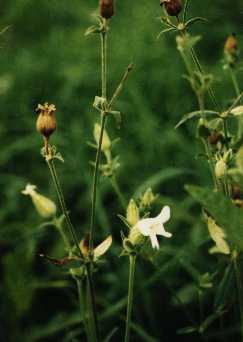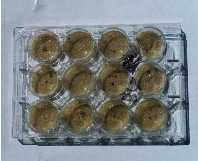Ecological Genetics of White Campion (Silene latifolia ) Seed Banks: A Comparison of Light and Dark Germination Among Maternal Families
Kelly N. Kiefer, Katherine R. Okey, and Patricia A. Peroni
Department of Biology, Davidson College
ABSTRACT
Many plant species maintain a seed bank. These
seed banks may function as reservoirs of genetic variation. Such genetic
banks could influence responses to novel selective pressures and ameliorate
the effects of inbreeding when population size becomes small. However, inadequate
knowledge exists for most species on whether or not differential survival
of genotypes in the seed bank actually occurs. Although a seed bank can
serve as the genetic "memories" of populations, these "memories"
may be selective.
White campion, a dioecious perennial herb, has served as the subject of
a metapopulation investigation in SW VA for the past decade. Seed dispersal
is extremely limited which means that the seed banks could stabilize the
dynamics of population fragments by providing means of reestablishing a
population and/or by minimizing the effects of inbreeding in a small population.
Peroni and Armstrong (in prep) and Peroni, Boozer, Whitehead, Marshall,
Kiefer, and Okey (in prep) documented the existence of white campion seed
banks, but have little information on the ecological genetics of these pools.
We chose to manipulate one environmental factor experienced by buried seeds
(darkness), and used maternal families of seeds to address the following
questions.
1. Do maternal families vary in ability to germinate in the dark?
2. How does the relative performance of the maternal families in the dark
compare with the performance in the light?
A significant interaction effect (family*treatment) was found for the
Whittaker population. Viability differed significantly between the populations,
but not among families within the populations. No correlation between mass
and percent germination within the populations was found.
METHODS
Seeds were collected from 2 populations
of Silene latifolia in Eggleston, VA, during summer of 1996.
5 families were selected from each population (10 families total).
Fifty seeds per family were assigned to light treatment and 50 seeds were
assigned to dark treatment.
Each seed was placed in a cell well plate containing sand and dH20.
Cell well plates were placed in a light (14 hr light/ 10 hr dark) or dark
incubator (22oC).
At day 11, germination for each seed was tallied.
Ungerminated seeds from light treatment were tested for viability.
Experiment was repeated switching incubators.


CONCLUSIONS
Maternal families of white campion display differing abilities to germinate
in the dark.
Relative performance in the light cannot always predict a family's relative
performance in the dark.
The differences in germination observed among maternal families could reflect
heritable differences and/or maternal environment effects. However, since
we found no correlation between mean family seed mass and percent germination
in either treatment, we suspect that the differences among families are
genetic in nature.
The white campion seed bank may contain only a selective subset of the genetic
variation found in a given seed crop.
IDEAS FOR FUTURE INVESTIGATION
Conduct controlled crosses in the greenhouse to control for variable maternal
environment effects, and repeat the investigation.
Compare seed survival of maternal families or different controlled crosses
during burial in the field.
Determine if inbred and outcrossed seeds vary in their ability to survive
burial (investigation underway).
Acknowledgements
Much gratitude to Katherine Okey and Wyatt Rivens for invaluable help and
to Dr. Patricia Peroni for her expert advice throughout this project.
© Copyright 2000 Department of Biology, Davidson
College, Davidson, NC 28036
Send comments, questions, and suggestions to: macampbell@davidson.edu